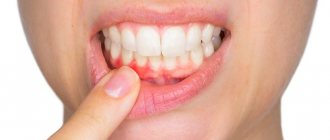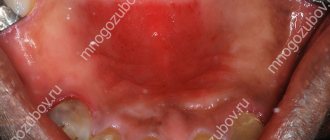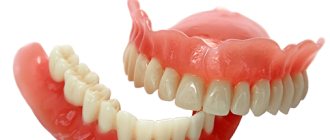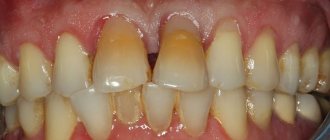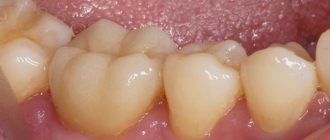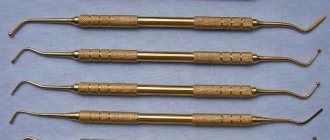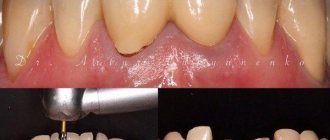Restoration with crowns is one of the options for restoring lost teeth. Installing a crown allows you to equally effectively restore both the functionality of the tooth and its aesthetics. Crowns can be recommended for installation on a tooth even if it has undergone severe destruction due to caries (more than 50%).
Installing crowns is a multi-stage procedure that has its own characteristics, which you can learn about in detail from this article. The material will introduce you to the indications and contraindications for installing dental crowns, tell you about all stages of the treatment process, and the types of crowns that can be used for dental restoration. Also in the article we will talk about whether it hurts to put a crown on a tooth and how you can remove the prosthesis from the tooth if complications arise after prosthetics.
What is a dental crown?
A dental crown is a non-removable dental prosthesis in the form of a single element, a kind of “cap”, which is made from impressions in a dental laboratory and then attached to the tooth. In this way, the crown, or visible part of the tooth is replaced if it is severely damaged, missing or has a serious aesthetic defect. Crowns will be required in order to fix a bridge or clasp prosthesis on supporting teeth, which may be completely healthy. You can “crown” not only a damaged natural tooth, but also, in the case of its complete absence, a dental implant.
The question of installing a crown usually arises if the crown part of the tooth is destroyed by more than 70%. In this case, you can forget about filling or microprosthetics with an inlay. They will not provide optimal redistribution of the chewing load. In the future, this threatens that improper pressure on the tooth will lead to its splitting and inevitable subsequent removal. Therefore, the choice between a filling, an inlay and a crown should be based solely on the indications.
What teeth are crowns placed on?
As a rule, crowns are installed on the lower and upper teeth without any fundamental differences; only the part that matters is the anterior or chewing one. For the smile zone, aesthetics is an important criterion for the quality of prosthetics. The prosthesis must be absolutely identical to natural teeth. In such cases, a crown made of solid ceramics or based on zirconium dioxide is placed. The main criterion for choosing structures for the chewing group is the strength possessed by metal, metal-ceramic and zirconium crowns. The crown on the wisdom tooth is fixed if the figure eight is in the correct position and is involved in chewing or is necessary to secure the clasp prosthesis.
Indications for installation of dental crowns
- Carious lesions in more than 50% of tissues;
- Aesthetic problems - large chips and cracks, discoloration;
- Fracture of the coronal part;
- Pathological abrasion of enamel.
The best dental crowns
Perhaps every patient who is thinking about prosthetics asks the question: “Which dental crowns are better?” We remind you once again that any decision, including the choice of crown material, should be made jointly by the doctor and the patient. A conscientious dentist will always tell you about the best crowns for the front teeth, all the options for prosthetics, as well as the pros and cons of one or another option specifically in your case. Thus, the best dental crowns are those that your doctor recommends. If we are talking about the advantages of materials, then the leaders here, without a doubt, are all-ceramic crowns made by pressing or by manufacturing using refractory models. They are ideal for anterior teeth from an aesthetic point of view, as they accurately reproduce the color and transparency of natural enamel, and are also strong enough to withstand the same chewing load that the patient's natural teeth can withstand.
Dental crowns on implants
When using implant prosthetics, the best option for restoring the front teeth, for which aesthetics is important, would be dental crowns made of metal-free ceramics. This is due to the fact that the metal can be seen through the ceramic, which imitates the transparency characteristic of natural dental tissue. Therefore, to achieve a high aesthetic result, the use of a zirconium abutment is recommended. When it comes to chewing teeth, aesthetics are not as important as functionality, so metal-ceramic dental crowns on implants may also be acceptable. For those patients who do not compromise between aesthetics and function, it is recommended to install zirconium dioxide crowns on the implant.
Preparation for prosthetics
Preparing to install a dental crown is a long process, but necessary if you want the denture to last for many years and not cause any discomfort. Classical training takes place in 7 stages.
- Examination by an orthopedist
The doctor can give an opinion on the advisability of prosthetics using a dental crown at the initial appointment after a thorough examination of the oral cavity. He will assess the condition of your teeth and gums. Offer an individual treatment plan. Will inform you about which crown material is preferable in your particular case. He will select the optimal color for the future crown so that it cannot be distinguished from natural teeth. Finally, he will calculate the final cost of the service and the deadline for its completion. - X-ray
Having a targeted X-ray image of the problem tooth is the main condition when preparing for prosthetics. Based on the data obtained from it, the dentist will be able to decide whether it is in principle possible to restore the tooth with a crown or whether it is worth looking for alternative solutions to the problem. - Therapy
The third fundamentally important stage is the treatment of all foci of infection in the oral cavity. Before installing a crown, it is necessary to remove accumulated tartar and treat caries. - Pulp removal
In most cases, crown replacement is preceded by the process of tooth depulpation (or, as patients often say, “nerve removal”). Exceptions are possible if we are talking about prosthetics of lateral chewing teeth. - Preparation
In other words, the grinding of a tooth, when a layer of dentin equal to the thickness of the future crown is removed. It is performed using local anesthesia and takes 1 hour. - Taking impressions
In order for the crown to fit on the tooth as accurately as possible, impressions are taken from the teeth. If the clinic has its own dental laboratory, then making a prosthesis will not take much time. - Installation of an intermediate structure
A temporary prosthesis is necessary when it comes to teeth in the frontal zone. It will prevent you from walking around with an unaesthetic ground tooth in the period between fitting and fixing the permanent crown.
What is preparation or grinding of enamel: a complete list of indications for this procedure
Article navigation
- What is preparation
- What preparation is needed before turning?
- Types of turning
- Peculiarities of turning for different types of prostheses
- Types of ledges when fixing crowns
- Features of the procedure in children
- Will it hurt when turning?
- What to do if there is pain after turning
- Is preparation always necessary?
- How much will the turning cost?
Question to a specialist
To restore “problematic” or missing teeth, we go to an orthopedic dentist who offers various prosthetic options. However, the installation of a veneer, crown, removable dentures or bridge is almost always preceded by dental grinding - and the very mention of it immediately frightens patients. What kind of procedure is this, in what situations is it used, will it hurt, what are the features of the preparation and how the process works in patients of different ages - all this is discussed in today’s material.
Installing a crown on a tooth
A dental crown is installed on one tooth in several stages.
- Diagnostics.
To find out whether it is possible to put a crown on a tooth, the doctor examines the oral cavity visually and necessarily sends it for an x-ray.
- Treatment.
Then the necessary treatment is carried out. Most likely, you will have to remove the nerve under the crown and fill the canals.
- Grinding of teeth for crowns.
If the dental tissue is slightly damaged, then the remaining walls are ground down. In the case where the “top” of the tooth is completely missing, a dental inlay is additionally installed under the crown, which will ensure its reliable fixation. Previously, instead of an inlay, a pin was installed; today, a dental crown on a pin is considered an outdated technique, which has a number of complications leading to tooth loss.
- Making dental crowns.
After all the preparatory procedures have been completed, impressions are taken from the patient and sent to a dental laboratory.
- Installation of dental crowns.
This is followed by fitting of the finished product in the oral cavity and installation. Many people are concerned with the question “What are dental crowns glued to?” Orthopedic structures are placed on special cement, which allows the prosthesis to stay in place for a long time and reliably.
All manipulations are carried out over several visits. Making dental crowns is possible in a few hours, provided the necessary equipment is available in dentistry.
Crown on a living tooth without pulp removal
If we are talking about grinding healthy teeth to fix a dental bridge, then an important question arises about the need to depulp the tooth. Everything here is very individual. But, as a rule, doctors prefer not to take risks and in most cases remove the nerve.
Color of dental crowns
Modern technologies make it possible to produce orthopedic structures indistinguishable from natural teeth. Naturally, we are talking about ceramic, metal-ceramic and plastic crowns, and not metal ones. Ceramics used in modern dentistry are able to completely imitate the color and transparency of the enamel of the teeth adjacent to the prosthetic. The same applies to the plastic used to make temporary crowns. But if we are talking about metal-ceramics, then crowns with a zirconium frame can “get into color,” and in the case of other metals, the frame can be visible through artificial enamel. In modern dental laboratories, the color and shade of enamel for crowns is selected according to the Vita scale, which represents the majority of natural tooth shades.
How are dental crowns removed?
There are 3 main ways.
- Kopp apparatus.
Using a special drill, the doctor breaks the cement at the base of the prosthesis, then removes the structure with forceps. - Sawing
. The structure is cut in the center and removed. - Coronaflex.
The crown is removed carefully and without damage using compressed air. The method is expensive, but after the procedure it is possible to re-install an artificial tooth.
Dental crowns are removed if the following problems occur:
Toothache under a crown
Modern materials make it possible to make dental crowns that fit as closely as possible to the tissues of the prepared tooth, however, sadly, the patient sometimes has the feeling that his dental crown hurts. Of course, it’s not the crown that hurts, but the tooth underneath it. Toothache under a crown can mean several different problems, but the most common is the formation of secondary caries in the area where the crown adheres to the tooth tissue. If this happens, be prepared to remove dental crowns, re-prepare the teeth and install new orthopedic structures. If this is not done, the tooth under the crown may completely collapse, leading to its loss.
Caries under the crown
Sometimes this is due to an error by a doctor or dental technician, when the procedures for making or installing a crown were violated: if it does not fit tightly to the tooth, if saliva got under it during installation, if caries was not completely treated, the formation of secondary caries under the crown is more than likely .
Unpleasant odor from under the crown
The smell from under the dental crown occurs when food debris or saliva gets under the denture. Bacteria multiply faster in this environment, causing an unpleasant odor. Inflammatory processes in the dental tissues under the denture also lead to an unpleasant odor.
Important!
Removing dental crowns and installing new ones must be done approximately every 10 years, otherwise you risk becoming one of those users who frantically write in the search bar in their browser: “I swallowed a dental crown, what should I do?!” By the way, modern materials for making crowns are absolutely non-toxic; sharp edges and chips pose a danger if swallowed. Therefore, if it was not a small piece of a fallen-off crown that was swallowed, but the entire structure or a substantial part of it, you should consult a doctor - a surgeon, a gastroenterologist, or the nearest emergency room.
When does pulp need to be removed?
Depulpation is not a mandatory procedure before prosthetics, but it cannot be avoided if there are the following indications.
- Advanced caries or caries at the very root of the tooth.
- Pulpitis or periodontitis.
- Partial exposure of nerves during grinding of enamel.
- Anatomically incorrect position of the tooth.
- Tooth injury, which may result in partial death of the nerves.
- Hypersensitivity.
- Low landing crown.
If there is a need to remove the nerve after the crown has been installed on a living tooth, then depulpation can be carried out without removing the crown. The doctor makes a hole, removes the nerve, and then fills the hole with polymer. After such a procedure, the prosthesis does not lose its performance properties.
Can a tooth crown be inexpensive?
The cost of a dental crown per tooth will directly depend on the type of material used, the method of its manufacture, the category of the clinic and its location, as well as the qualifications of the orthopedic doctor. For example, in Moscow, prices for metal crowns can vary from 3,000 to 16,000 rubles, for metal-ceramic crowns - from 7,000 to 40,000 rubles, and the average cost of a ceramic crown is about 21,000 rubles. You can find out in more detail how much a particular dental crown will cost for one tooth during an in-person consultation at a dental clinic.
Restoration of dental crowns
Dentures, like natural teeth, require care - careful oral hygiene and restoration of dental crowns. Service life and repair requirements depend on the material. Structures made of ceramics and metal-ceramics are susceptible to the formation of defects. Zirconium dioxide is more durable and cannot be broken or scratched. A zirconium prosthesis lasts about twenty years and does not require repair. As a rule, indications for restoration of the tooth crown are chips, cracks and discoloration of the structure. The procedure should only be carried out by a specialist; experiments at home often lead to breakage of the prosthesis or damage to healthy teeth.
Features of caring for metal ceramics
Everyday hygiene measures do not differ from normal procedures - it is important to brush your teeth twice a day, and also rinse your mouth, if possible, after eating.
Cleaning the teeth should be carried out as follows: using sweeping movements, you need to go over all the teeth in the direction from the gums to the cutting edge. You should not ignore the use of dental floss, or better yet, an irrigator.
You can clean metal ceramics in the same way as regular teeth - a toothbrush should be purchased in accordance with the doctor’s recommendations (the degree of stiffness of the bristles is determined by individual characteristics), the toothpaste can also be selected based on your needs.
Remember that it is better to protect metal-ceramic structures from mechanical damage. It is not recommended to bite into hard foods - this can result in cracks and chips, and subsequent breakage of the prosthesis.

